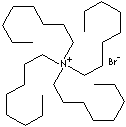| CAS
NO. |
14866-33-2 |

|
| EINECS
NO. |
238-936-9 |
| FORMULA |
[CH3(CH2)7]4NBr |
| MOL
WT. |
322.38 |
|
H.S.
CODE
|
2923.90 |
|
TOXICITY
|
|
| SYNONYMS |
Tetra-n-octylammonium bromide; |
| Bromure de tétraoctylammonium;
N,N,N-trioctyl-1-octanaminium bromide; Bromuro de tetraoctilamonio;
|
|
SMILES |
|
|
CLASSIFICATION
|
|
|
PHYSICAL AND CHEMICAL PROPERTIES
|
| PHYSICAL
STATE |
White to off white crystalline
powder, odorless |
|
MELTING
POINT
|
95
- 98 C |
| BOILING
POINT |
|
| SPECIFIC GRAVITY |
|
|
SOLUBILITY
IN WATER
|
|
|
pH
|
|
|
AUTOIGNITION
|
|
| VAPOR DENSITY |
|
|
NFPA
RATINGS
|
|
|
REFRACTIVE
INDEX
|
|
| FLASH
POINT |
Not expected to be a fire hazard |
| STABILITY |
Stable
under ordinary conditions.
|
|
GENERAL
DESCRIPTION & APPLICATIONS
|
Quaternary ammonium compounds are any of a group of ammonium salts in which
organic radicals have been substituted for all four hydrogens of the original
ammonium cation. They has a central nitrogen atom which is joined to four
organic radicals and one acid radical. The organic radicals may be alkyl, aryl,
or aralkyl, and the nitrogen can be part of a ring system. They are prepared by
treatment of an amine with an alkylating agent. They show a variety of physical,
chemical, and biological properties and most compounds are soluble in water and
strong electrolytes. In addition to their tendency of locating at the interface
of two phases (liquid–liquid or solid–liquid) to introduces continuity between
the two different phase, they have properties of disrupting micro-organisms'
cell processes. These compounds are used as ;
- Surface-active
agents
- Solvents
- Intermediates
- Active Ingredient for Conditioners
- Antistatic Agent
- Detergent Sanitisers
- Softner for textiles and paper
products
- Phase Transfer Catalyst
- Antimicrobials
- Disinfection Agents
And Sanitizers
- Slimicidal Agents
- Algaecide
- Emulsifying Agents
- Pigment Dispersers
|
| SALES
SPECIFICATION |
|
APPEARANCE
|
White to off white crystalline
powder |
| ASSAY |
99.0%
|
|
FREE
AMINE
|
0.5%
max
|
|
ASH
|
0.5%
max
|
|
MOISTURE
|
0.5%
max
|
| TRANSPORTATION |
| PACKING |
|
| HAZARD CLASS |
Not regulated |
| UN
NO. |
|
| OTHER
INFORMATION |
|
Hazard
Symbols: XI, Risk Phrases: 36/37/38, Safety Phrases: 26/37/39 |
